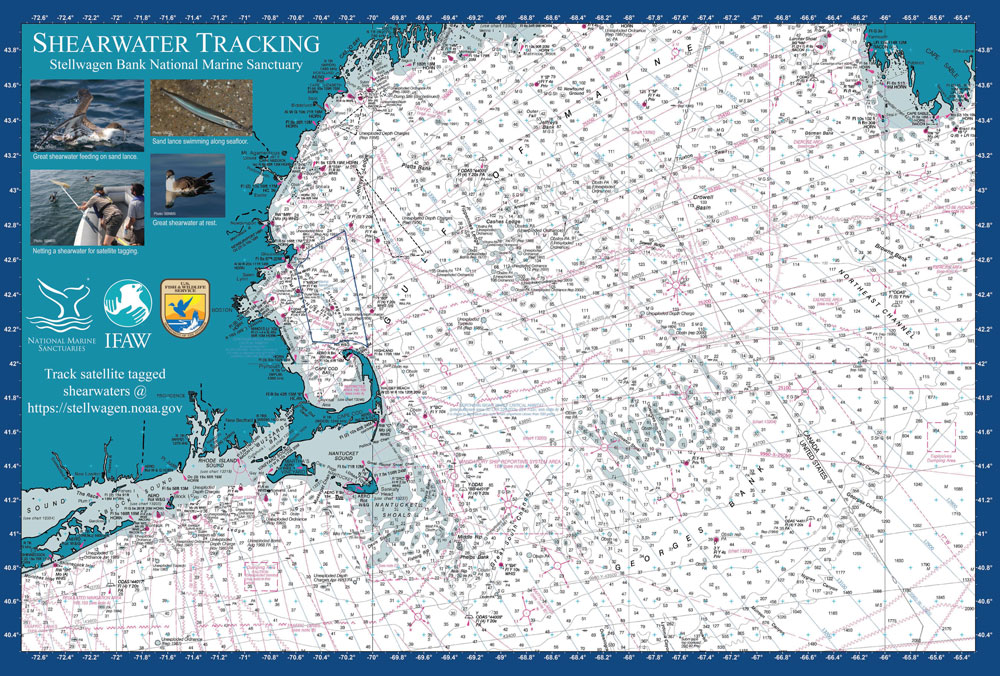
Sanctuary scientists want to learn more about how seabirds react to changes in their primary food source and what factors cause changes in forage fish abundance. Signals from the tags have allowed scientists to plot bird movements. They can then relate the movements to oceanographic features such as water temperature, bathymetry, chlorophyll concentration, ocean fronts and other factors that might result in increased productivity or that concentrate prey. This year, two tagging missions will attempt to tag sets of mature and immature birds to study differences in feeding patterns and migration routes.
On July 13 and 14, 10 great shearwaters were tagged for the annual project. An earlier mission in June found that the captured birds were all below the required weight as necessitated to carry a tag. Great shearwaters come to the Stellwagen Bank National Marine Sanctuary and other areas in the Northwest Atlantic to feed and bulk up for the long migration to their breeding grounds in the South Atlantic in our winter (their austral summer). June was just too early. An additional five tags acquired for the project will be applied to birds captured in September.
Summary reports of the birds’ travels and cumulative maps of each bird’s tracks will be updated monthly. The maps are to be used for educational purposes only. For more timely notices, check our Twitter (@NOAASBNMS) and Facebook and the project's associated twitter account @TrackSeabirds.
By the end of August, seven tags were still signaling and the birds were traveling – some of them over quite impressive distances. Five birds finished the month in the Gulf of Maine, either on Georges Bank (Tuskegee, Birdy McBirdface, Shuri) or in the Great South Channel between Georges Bank and Nantucket Shoals (Volgenau8 and Jemison). One bird (Bessie, named after the first Black/Native American woman to obtain a pilot’s license) has made a fairly straight flight NE to the Grand Banks and at the end of the month was just west of the Flemish Cap. This may be a breeding bird beginning the long-distance migration that will eventually take it down to the southern South Atlantic. The last bird has the most unusual track – the bird seems to be stretching its wings and trying something a bit different. Britney Shears was located south of Long Island near Hudson Canyon and then continued to move southward off the continental shelf.
Total distances traveled for all birds (as of 8/29/21, including those birds whose signals are no longer received):
Arliner (stopped 8/18/21): 3,907 km
Ashanti (stopped 7/22/21): 503 km
E.E. Just (stopped 8/21/21): 1,108 km
Bessie: 5,953 km
Birdy McBirdface: 5,233 km
Britney Shears: 4,444 km
Jemison: 4,232 km
Shuri: 5,156 km
Tuskegee: 6,390 km
Volgenau8: 7,730 km
Of the ten satellite tags, one seems to have failed (Ashanti) but the other nine continue to send signals. All tracks started just east of Chatham, Massachusetts where the science team captured, sampled, tagged, and then released the birds.
The seabirds appear to be using two distinct feeding areas. One group – Arliner, E.E.Just, Jemison, and Shuri are staying around the outer Cape Cod slope including northward to Stellwagen Bank or southward to Nantucket Shoals and Great South Channel areas. The second group – Bessie, Ashanti, Volgenau8, Tuskegee, and Britney Shears have targeted Georges Bank. Volgenau has logged the most distance as of July 26 (1,702 km). Before its tag stopped transmitting, Ashanti appeared to be moving along the tidal front on northern Georges Bank. Birdy McBirdface is in both groups and seems to be quite the traveler (1,273km).










For Educators: The sanctuary offers two maps for tracking shearwater movements. One map is for the Gulf of Maine and the second is of the Atlantic Ocean (North and South Basins). The coated surface on the paper allows for the placement and removal of sticky dots for repeated use. The sanctuary education team has prepared a generic tracking activity and other background materials. Email stellwagen@noaa.gov for more information.
The Team: Dr. David Wiley, research ecologist for the sanctuary, leads the shearwater tagging project. Additional sanctuary staff include Michael Thompson, sanctuary geographer and GIS specialist, and Dr. Tammy Silva, postdoctoral researcher, along with Kevin Powers, a volunteer with the Stellwagen Sanctuary Seabird Stewards program and seabird expert. The research team includes Linda Welch, U.S. Fish and Wildlife Service seabird specialists at the Maine Coastal Islands National Wildlife Refuge, Dr. Les Kaufman, Boston University, Dr. Kent Hatch, Long Island University, Dr. Anna Robuck, University of Rhode Island, and Dr. Robert Ronconi Environment and Climate Change Canada. Funds for the project have been provided by the Volgenau Foundation, Bureau of Ocean Energy Management, the Davis Foundation, and the Mudge Foundation.